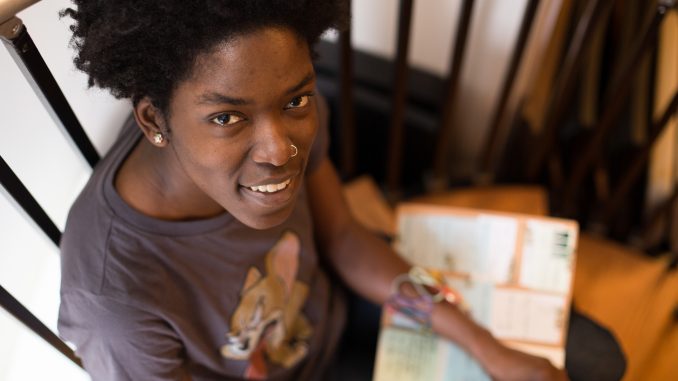
As an undergraduate studying fiber art at Tyler School of Art, Reece Ford was not always interested in doing the same thing as her classmates.
For one decomposed basket weaving assignment, she said she took home extra materials and came back with a “thing.”
“I didn’t really know what I was doing,” Ford said. “I just wanted whatever I was making to be functional and the class kind of went crazy, so I kept making pieces and I kept making necklaces.”
“The one thing I couldn’t do was I couldn’t replicate the same thing,” she added. “I tried to make the same necklace over again and it just wasn’t working, so that was one piece of that puzzle that I just thought, ‘You know what, that’s fine,’ because that’s very much so like me.”
Lorraine Glessner, one of Ford’s fibers professors, said it was not unusual for Ford to take the techniques she was taught and make them her own. In one of her classes, Glessner was teaching a lesson about using wax to create patterns on fabric, but Ford wanted to learn a specific wax technique: batik.
“She took the process I was teaching and made it into almost a traditional batik process, but not,” Glessner said. “She just took it and made what she wanted it to be. She had done this beautiful sample with it that just had depth and color and layers and it was just gorgeous and it stood out among all the other students’ work for that particular assignment.”
The 2013 alumna developed her process of making one-of-a-kind pieces and turned it into a jewelry collection called Voro Mana, a play on the Italian phrase for “work week.” Ford said the collection revolves around the idea that “no two days are the same,” just like no two of her pieces are the same.
Voro Mana stems from the relationships Ford feels between the days of the week, music and colors. She said her uncle, a holistic doctor, taught her that certain colors should be worn on certain days of the week and Ford attached her own feelings, music and meanings to each day.
“If I’m [working with] black I’m usually in a jazz mode, or sometimes I’ll even listen to classical music or metal,” she said. “It’s not being stereotypical, it’s just also how I feel that day. I have realized that the colors in conjunction with the music definitely influences how the piece is going to be made.”

“Music heavily influences what I do because when I’m making something, I can’t really watch anything visual, I have to listen to music,” Ford added. “Music has rhythm, it has motion, even if you don’t see it. That’s how when you dance, you’re dancing to the rhythm of the beat. That’s kind of what my pieces are doing. They’re dancing to the rhythm that I was listening to that day.”
Music and colors help Ford create pieces for Voro Mana, each of which corresponds to a day of the week and has an individual number based on when she made it. She said every piece reflects the kind of music she listened to while making it.
Ford’s designs are structured by the fibers she made them with, but they appear to flow and dance the way her favorite songs do. The curvy, tangled statement necklaces all have a similar design process, but each one is a little bit different, depending on Ford’s mood.
“There are certain ones where I was into metal and I can tell that I was listening to metal music because the shapes will be different than if I was listening to jazz or Rihanna or Beyoncé. It’s a very different flow that moves through each piece,” she said.
Ford is a member of RAW, a national art collection that showcases local artists in different cities and provides networking opportunities, shows and other perks like headshots and product photography. Voro Mana will be featured in a RAW “Signature” showcase on April 20 at the Trocadero Theatre.
“She’s into a lot of stuff,” Glessner said of Ford. “She has a very eclectic life. She just has an energy and a presence. She has a presence and it’s not authoritative, but it’s just dignified. She’s dignified in her presence.”
Although Ford focuses on fiber arts and design, she is also a model. Ford said she models for professional designers, her friends’ vintage clothes and, most recently, vintage lingerie.
“It made me have a new appreciation for myself, one that is a different gift than the pieces that I make,” she said. “I hope that I can influence other people of all shapes, sizes and ethnicities to embrace who they are. With my art, that is what I want to do.”
Erin Moran can be reached at erin.moran@temple.edu.


Be the first to comment